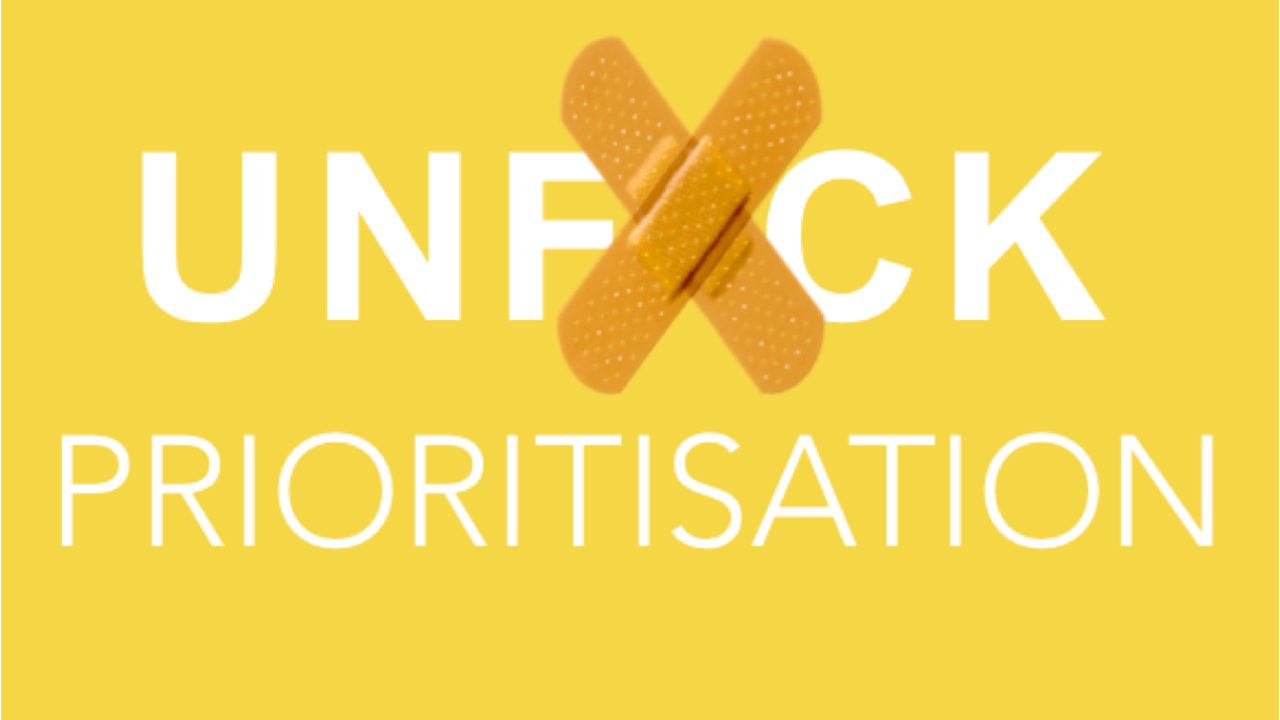Unfu*king prioritisation

Alongside the current decluttering and unfu*king ourselves craze sits the perennial issue of prioritisation.
It’s something we grapple with on an individual level; “how should I spend my time?” and an organisational level; “where should we spend our resources?”
The tangle is not at the extremes – it is obvious what we should definitely do or not do – but the murky middle.
So I’ve been working on a way to behaviourally optimise the prioritisation process, which I’d like to share with you in this post.
The problem with old prioritisation processes
There are three reasons we struggle with prioritisation. People don’t like giving up opportunities (loss aversion), don’t like to walk away from things (sunk cost fallacy and endowment effect) and are overly optimistic (planning fallacy).
In the excitement of listing everything we could do, we forget about opportunity cost and end up with more priorities than we can deal with. This is a problem.
A 2011 survey involving 1,800 executives found:
- 64% reported they had too many conflicting priorities
- 81% admitted their growth initiatives lead to waste
- When the number of priorities increased, revenue performance decreased

Behaviourally effective prioritisation
The key to prioritisation is to build tension about choices so the downside of proceeding is captured as well as the upside of not proceeding. It’s kind of like a reverse business case where you want to argue against committing resources.
Here’s how it works.

Column A - Designations
Ultimately, initiatives get prioritised as one of five types:
- Must do
- Nice to do
- Could do
- OK not to do
- Should not do
The descriptors are in plain language like “must do” and “nice to do”, which are probably familiar to you from other prioritisation models. You may not have used “OK not to do” before, however. It’s there because people need to feel comfortable about not doing something to overcome their attachment to an idea.
To get to the descriptors, of course, you may need to run through columns B-F first (I have a free tool online for this which I’ll explain below.) Let me take you through each column, including why some of the language used is important.
Column B -Building a reverse case
Column B asks you to note what happens if you don’t do something. We ask this question to tease out the implications of a “do nothing” strategy for two reasons:
- It makes doing nothing unpalatable for those initiatives that are “must do” and galvanizes the team around it; and
- It lets us talk about the upside of not taking on projects we shouldn’t. For instance, if we don’t do this it relieves us of the pressure to do too much (“OK not to do”) or avoids the team splintering in different directions (“Could do”). Most explicitly, people like avoiding “mistakes”, which ramps up the power of “shouldn’t do”.
Columns C&D - Upside of proceeding
Proceeding with a project can have two types of upside. The first is a positive outcome (e.g. more customers, market share, revenue) and the second is the avoidance of a negative outcome (e.g. complying with regulation).
Column E - Downside of proceeding
There can sometimes be a negative outcome for doing something that far exceeds any potential positive. For example, sponsoring the Fyre festival or arranging subprime mortgages!
Column F - Impact on resources
It can be helpful to remind people that the choices we list carry a real cost on resources. We are deliberately upping the stakes by including this column, recognising the opportunity cost of our decisions.
- Those things that we choose to do (“Must do”, “Nice to do” or “Could do”) involve spending resources if they proceed.
- Those things we choose not to do (“OK not to do” or “Should not do”), actually save resources which we can use elsewhere.
Language to use
As you work through a prioritisation exercise, try to stick with plain language as much as possible. In my experience, the more corporate-speak is used, the more abstract the projects become and people start to forget they involve real people spending real money and time on real things.
Using inclusive language like “we” and “us” is also important to prime people for a team approach. People might be making a prioritisation assessment about a project they will not work on directly, but will need to feel there is a collective interest for the business in having it succeed.
About the free Prioritisation Wizard
As I was designing this behavioural approach to prioritisation I thought “how can I make it easier?” By creating a self-guided question and answer process, of course.
If you are struggling to know whether your initiatives are Must Do, Nice to Do or OK not to do, the online wizard will help. Use it as often as you like and let me know how you go.

